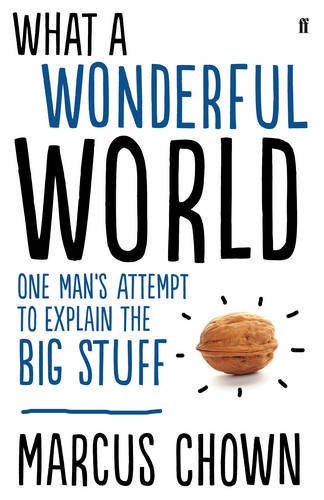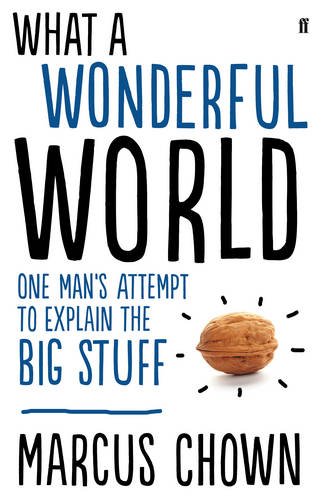So I’m delighted to announce that Marcus Chown, science writer and all round good guy, is back on The Book of Lost Nights to answer my thorny and possibly inane science questions as part of his new blog tour, and I’m absolutely thrilled.
This time we’ll discover what the deal is with lightning and rubber shoes, whether Greenpeace’s activities should extend to other planets, and also if things in space have to actually crash on the Earth to trigger Armageddon, amongst other cool stuff.
Let’s get cracking…
1. Do you think terraforming another planet or moon is a) possible and b) ethical? Even nominally uninhabited planets? I mean, we admire the natural beauty of Antarctica, and nobody is talking about terraforming that.
Hi, Helen!
a) Yes, I think it is possible – though it is probably more difficult than people think. We have already knocked the Earth out of balance and, although people talk of technological fixes to knock it back, these are likely to be very hard, if even they are possible, with all sorts of unintended and unanticipated consequences. The same will be true on other planets and moons but they are much further away from the inhabitable state we would be aiming for.
b) Well, as you say, other planets and moons are even more pristine – that is, even more untouched by humans – than Antarctica. And we have an international agreement not to spoil Antarctica – though, as we run short of resources, the pressure to scrap the understanding will increase.
But the big concern is: do planets like Mars and moons like Jupiter’s Europa and Saturn’s Enceladus support microbial life? If they do, then do we have the right to contaminate them with Earth organisms? If life has arisen independently – or even by the transfer of bacteria in meteorites between worlds, so-called planetary panspermia – it would be scientific sacrilege to contaminate it. We would miss the priceless opportunity to study a second biology – the opportunity to understand what is special about life and what is general. A second example of Life might help us answer the ultimate biological question: how did life get started?

2. Are there any circumstances under which an exoplanet (one not attached to a solar system) could support life?
Yes. The newborn Earth was shrouded in a blanket of molecular hydrogen from the protoplanetary nebula. When thick – and around the young Earth it would have been about 10,000 times thicker than the planet’s current atmosphere – molecular hydrogen is a fantastic greenhouse gas. Of course, the powerful solar wind of the newborn sun quickly stripped away this molecular hydrogen mantle.
But here’s the interesting thing. Computer simulations of the birth of the Solar System often show around 10 Earth-mass bodies being ejected by close gravitational encounters with embryonic gas giants like Jupiter. These brothers and sisters of Earth could at this moment be wandering thorough interstellar space. According to David Stevenson of the California Institute of Technology in Pasadena, such “orphan planets”, heated by volcanism and internal radioactivity, could stay warm enough for liquid water to exist on their surfaces for around 10 billion years – twice the current age of the Earth. Do the calculations: 10 interstellar planets for every Earth. The most likely place to find life may be in the cold, dark freezer of interstellar space! (I wrote about this in the chapter “The worlds between the stars” of my book The Universe Next Door (Headline).
3. This one is slightly gruesome but had me absolutely spellbound at the time I heard it – I was once told that the tsunami that inundated Doggerland and made Britain an island at the end of the last Ice Age was so strong that anyone caught in it would be ripped limb from limb from the force of the water. I’ve puzzled a lot about this – can water shear you apart when there’s nothing to hold you still? And if so, could water generate that kind of natural pressure on Earth? I could see that you could be pounded to death – but could you really be torn apart?
I’m puzzled too! The tsunami itself is just a hump of water, created as some event such as a subsea earthquake, momentarily lifts and drops the sea. It is amplified as it reaches shallow water. Eventually, it breaks, creating turbulence. It is the turbulence that can squeeze together and pull things apart thing. But it is hard to imagine it would be strong enough to rip apart a person. Far more likely is that a person would get pounded by debris caught up in the turbulence. Of course, I am not an expert this area. So I could be wrong!
4. There was a lot of talk at one point about one of our celestial neighbouring stars undergoing a supernova explosion and the usual scare stories did the rounds. But if there is a supernova near us, is it correct to say it would be harmless? What if it became a pulsar, would that affect our bodies or electronic communications? And if so, presumably it would take a while to become apparent, since nothing travels faster than light?
If a nearby star went supernova it would be far from harmless. Say, one went off within 10 parsecs – roughly 30 light years – of the Sun. This must have happened several times in the 4.55 billion year history of the Earth. Just 30 years after the explosion, the Earth would be raked by deadly gamma rays. Then, about three centuries later, the blast wave of high-speed subatomic particles would arrive, stripping away the ozone layer that protects life on Earth from solar ultraviolet light. All life, apart from that below ground and in the oceans, would be wiped out. The novel, Supernova, dramatised the effect of a supernova going off within 10 parsecs of the Earth.
Gamma ray bursters, a rare type of supernova, whose blast is directed not in all directions but in one direction like a lighthouse, are another story. Such objects would be powerful enough to affect the Earth no matter where they went off in the Milky Way. If we happen to be unlucky enough to be looking down the barrel of the gun!
But you also mentioned pulsars – the super-compact spinning relic often left after a supernova explosion. They are tiny and very weak and so have no effect on us. However, there is a class of pulsars known as magnetars, with super-strong magnetic fields, and these can affect us. For instance, on 27 August 1998, SGR 1900+14, a magnetar 15,000 light years away in the constellation of Aquilla, underwent a “starquake”. Even at that fantastic distance, the X-rays from the star were powerful enough to strip the electrons from atoms in the Earth’s upper atmosphere, disrupting low-frequency radio communication round the globe. Had you been in Earth orbit on 27 August, you could have had your teeth X-rayed for free!
The upshot of all this is the realisation is that the Earth does not exist in splendid isolation. Cosmic events can affect our planet – even catastrophically. But such events are unlikely. No need to lose any sleep over it tonight!
5. And finally a personal favourite – how, if you’re walking on a golf course and hit by lightning, can the fact you’re wearing rubber shoes possibly save you? Why can’t rubber conduct a current? Or is that an urban myth?
Lightning seeks out the easiest path from cloud to ground. Which is why, if you’re out on a golf course, during a lightning storm – especially if your hair starts to stand on end and your skin tingle – you should immediately throw yourself flat on the ground. Then, hopefully, something taller than you, like a bush or tree, will take the hit. But, if you are the easiest path from cloud to ground, your rubber boots will not save you. The enormous electric field in lightning will even break down even an electrical insulator like rubber so that the massive current can flow into the earth.
I can be a bit of lightning bore. Every second there are about 100 lightning strikes across the world. The massive electrical current surges down a channel about the width of a pencil, heating the air to about 50,000 degrees, 10 times the surface temperature of the Sun. That’s why lightning glows. It’s the supersonic expansion of the super-heated air that causes the sound of thunder.
Thanks so much to Marcus for the wonderful answers – loads to think about here! You can also check out Marcus’ previous Q&A (and do, it was a lot of fun and very interesting) “Would my Doomsday device destroy the world or just Islington?”. You can also read my reviews of his previous books The Afterglow of Creation and We Need to Talk About Kelvin, and I’m delighted to say that I’ll be posting a review of the new book, What A Wonderful World, next week.
So watch this space!
And you can catch the next part of Marcus’ blog tour at Annabel’s House of Books, October 12th.

